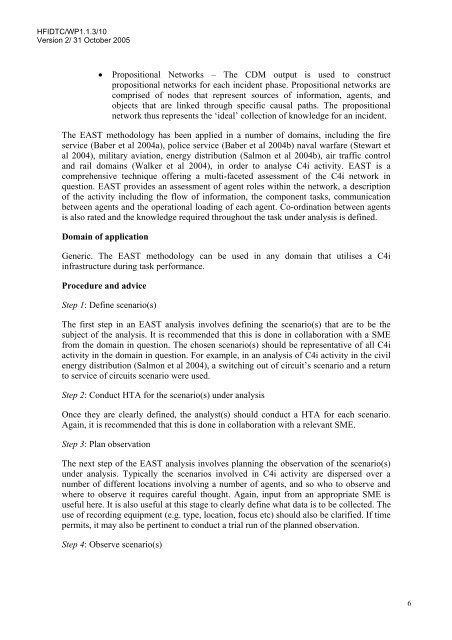A Review of the Event Analysis of Systemic Teamwork Methodology
A Review of the Event Analysis of Systemic Teamwork Methodology
A Review of the Event Analysis of Systemic Teamwork Methodology
- No tags were found...
You also want an ePaper? Increase the reach of your titles
YUMPU automatically turns print PDFs into web optimized ePapers that Google loves.
HFIDTC/WP1.1.3/10<br />
Version 2/ 31 October 2005<br />
• Propositional Networks – The CDM output is used to construct<br />
propositional networks for each incident phase. Propositional networks are<br />
comprised <strong>of</strong> nodes that represent sources <strong>of</strong> information, agents, and<br />
objects that are linked through specific causal paths. The propositional<br />
network thus represents <strong>the</strong> ‘ideal’ collection <strong>of</strong> knowledge for an incident.<br />
The EAST methodology has been applied in a number <strong>of</strong> domains, including <strong>the</strong> fire<br />
service (Baber et al 2004a), police service (Baber et al 2004b) naval warfare (Stewart et<br />
al 2004), military aviation, energy distribution (Salmon et al 2004b), air traffic control<br />
and rail domains (Walker et al 2004), in order to analyse C4i activity. EAST is a<br />
comprehensive technique <strong>of</strong>fering a multi-faceted assessment <strong>of</strong> <strong>the</strong> C4i network in<br />
question. EAST provides an assessment <strong>of</strong> agent roles within <strong>the</strong> network, a description<br />
<strong>of</strong> <strong>the</strong> activity including <strong>the</strong> flow <strong>of</strong> information, <strong>the</strong> component tasks, communication<br />
between agents and <strong>the</strong> operational loading <strong>of</strong> each agent. Co-ordination between agents<br />
is also rated and <strong>the</strong> knowledge required throughout <strong>the</strong> task under analysis is defined.<br />
Domain <strong>of</strong> application<br />
Generic. The EAST methodology can be used in any domain that utilises a C4i<br />
infrastructure during task performance.<br />
Procedure and advice<br />
Step 1: Define scenario(s)<br />
The first step in an EAST analysis involves defining <strong>the</strong> scenario(s) that are to be <strong>the</strong><br />
subject <strong>of</strong> <strong>the</strong> analysis. It is recommended that this is done in collaboration with a SME<br />
from <strong>the</strong> domain in question. The chosen scenario(s) should be representative <strong>of</strong> all C4i<br />
activity in <strong>the</strong> domain in question. For example, in an analysis <strong>of</strong> C4i activity in <strong>the</strong> civil<br />
energy distribution (Salmon et al 2004), a switching out <strong>of</strong> circuit’s scenario and a return<br />
to service <strong>of</strong> circuits scenario were used.<br />
Step 2: Conduct HTA for <strong>the</strong> scenario(s) under analysis<br />
Once <strong>the</strong>y are clearly defined, <strong>the</strong> analyst(s) should conduct a HTA for each scenario.<br />
Again, it is recommended that this is done in collaboration with a relevant SME.<br />
Step 3: Plan observation<br />
The next step <strong>of</strong> <strong>the</strong> EAST analysis involves planning <strong>the</strong> observation <strong>of</strong> <strong>the</strong> scenario(s)<br />
under analysis. Typically <strong>the</strong> scenarios involved in C4i activity are dispersed over a<br />
number <strong>of</strong> different locations involving a number <strong>of</strong> agents, and so who to observe and<br />
where to observe it requires careful thought. Again, input from an appropriate SME is<br />
useful here. It is also useful at this stage to clearly define what data is to be collected. The<br />
use <strong>of</strong> recording equipment (e.g. type, location, focus etc) should also be clarified. If time<br />
permits, it may also be pertinent to conduct a trial run <strong>of</strong> <strong>the</strong> planned observation.<br />
Step 4: Observe scenario(s)<br />
6
















